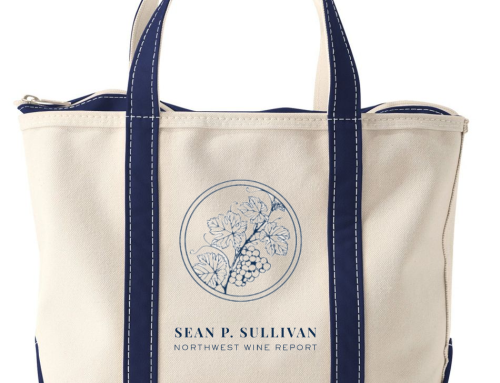
Both wines sampled here are classic examples of Washington Merlot. Additionally, both are quite distinct from each other, displaying the varying styles of Merlot being made in the state. The Columbia Valley offering is an appealing, exceptionally well balanced, polished wine. Northstar makes a staggering ten thousand cases of the Columbia Valley offering, giving this wine an extremely wide reach. The Walla Walla Valley wine, on the other hand, offers a bit more complexity on the nose as well as more intensity and boldness on the palate. Among other sources, fruit for the Walla Walla Valley wine comes from Spring Valley Vineyard, one of the finest producers of Merlot in the state, and Loess Vineyard, an estate vineyard for Leonetti Cellar. While both the Columbia Valley and Walla Walla wines are impeccably made, I would give a very slight edge to Walla Walla offering. It provides a bit more of the boldness of Merlot that is a hallmark of Washington State.
My only qualm with either of these wines – and it is a small one – is that both are just over the line in terms of being labeled a Merlot. The Columbia Valley Merlot comes in at 76% (75% is required for varietal labeling) and the Walla Walla Valley wine comes in at 78%. The balance of the wines are other Bordeaux varieties. Indeed, both could easily be classified as Bordeaux-style blends.

Northstar Merlot Columbia Valley 2006 $40
Rating: * (Excellent) Initially fairly quiet on the nose. As it opens up, shows oak spices, a hint of mocha, and light red and black fruit. Exceptionally well balanced on the palate with lithe fruit and silky oak buffeted by polished tannins. An exemplary Washington State Merlot. 76% Merlot, 19% Cabernet Sauvignon, 3% Petit Verdot, and 2% Cabernet Franc. Aged in French (70%) and American (30%) oak (65% new). 14.7% alcohol. 10,000 cases produced.
Northstar Merlot Walla Walla Valley 2006 $50
Rating: * (Excellent) Takes some time to open up but once it does this wine sings. An intriguing, complex nose with spice, tobacco, cocoa, dark fruit, and a light earthiness. Glides along the palate with a bit more fruit intensity than the Columbia Valley offering. Lingers on the finish. A prototype for Washington Merlot in general and Walla Walla Valley Merlot in particular. 78% Merlot (Spring Valley, Anna Marie, and Loess vineyards), 17% Cabernet Sauvignon (Anna Marie and Loess vineyards), 5% Cabernet Franc (Minnick Hills Vineyard). Aged in French oak (56% new). 2,500 cases produced.








In other countries, 85% is the minimum to be labeled by varietal. To fall below this floor, c'mon you can say it, tells me their merlot is not strong enough to stand on its own.
A cabernet to "soften" merlot?? A red flag just went up on 'truth in advertising.'
Mike Januik's merlots are over 95% varietal.
Crap, and I have a bottle of Northstar's 2005 CV merlot. It better taste like an effin' merlot. ~WAwineman
WWM, I too was struck by the 'Cab to soften Merlot'. Unusual! My sense is that, more than the Merlot not being able to stand on its own – I'm sure that it can given the excellent sources they are using – the winery is looking to make the best *wine* possible rather than the *purest expression of Merlot* possible. Both legitimate obviously. I'd love to see Northstar go up over 85% personally. Will have to check and see if they do something like this for their wine club. Thanks for the comment.
For the last two decades, I've had the opportunity to taste a lot 100% Washington Merlot and Cab Sauv at every stage of production, from wine that has just completed fermentation to wine that is in the process of being bottled. My experience is that — all other things being equal — WA Merlot (emphasis on *WA*) does indeed tend to be "bigger" than WA Cab Sauv (esp. tannin structure). It's one of the aspects of Washington viticulture that makes it unique from California and most other wine regions of the world. Depending on the vintage, there are probably years when Cab does indeed soften the Merlot base of a WA wine. My guess is that Northstar doesn't target a lower percentage of Merlot, but thought in that particular vintage, more Cab was needed to reign in the Merlot. Shame on Northstar for trying to make a better wine while operating within the Federal guidelines! ~ITB
ITB, thanks for the comment. Indeed, Merlot can turn into quite a big wine in Washington State. I've tricked many a friends into guessing a Merlot was a Cabernet in blind tastings. Ironically, some of them when I told them it was Merlot suddenly didn't like it! Like I said, the qualm is a small one. The results on these wines are inarguable.